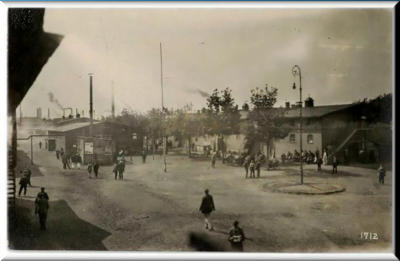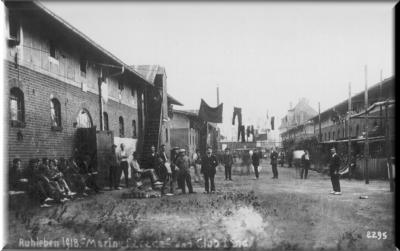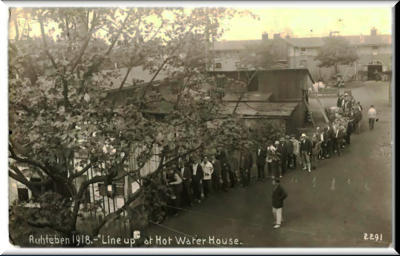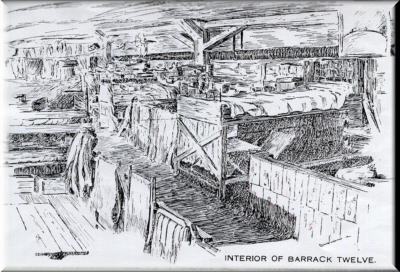


© Palatine Lodge - 1893 - 2023 - In se ipso totus teres -
There were two huge problems: there was no surface drainage, and the stables, most of which
were constructed of brick and concrete were poorly lit, not only unheated but partially open to the
elements, damp, dirty and insufficient to cope with the sheer number of men who needed to be housed.
Some of them had to be mucked out before they could be used at all. Each of the eleven stables
contained 27 horse boxes measuring about eleven feet square, some accounts say only 10 feet square
and, initially, most of the prisoners had to sleep on a thin layer of dirty straw on the concrete floors. After
some time, sacks filled with straw were provided known as rattresses because, from the outset, rats were a
huge problem. A single, worn horse cloth was the official allowance of bed clothes.
Eventually, into each of these boxes 6 bunk beds were crowded, 2 rows of beds, 3 tiers high. So, six
men and all their possessions had to exist in this area of no more than 121 sq. ft. That's 11 stables, each
with 27 horse boxes, containing 6 men. Gives us a total of 1782. So what happened to the other 2000 plus?
it turned out that the ones crammed into the horse boxes were the lucky ones. The German authorities
had woefully underestimated the numbers involved and the remainder lived and slept literally shoulder to shoulder in closely packed rows, up to 200 of them in each dimly lit loft above
the stables and, in this confined space, they had to live, eat, sleep, keep all their clothes and any belongings and even dry their washing. The Tea House and one of the grandstands was
also pressed into service for temporary housing. The only light in the stables came from a single bulb hanging in the corridor. There was a limited number of cold-water taps, which froze
during the first winter, 15 bowls per barracks were provided for some 362 men to wash and, of course, there was a complete lack of privacy.
By the autumn of 1914, the grounds were a sea of liquid mud. The American Ambassador, who
was charged with the welfare of British prisoners of war, visited the camp the following March and was so
shocked by what he found that he informed the German authorities that the conditions in Ruhleben were
a disgrace to humanity and brought shame on the German nation. After his intercession, materials and
tools were provided for the prisoners to build raised causeways between the barracks and the kitchens,
washing facilities and latrines and the interned engineers put in drainage. The centre of the Camp became
Trafalgar Square the somewhat ornate entrance gate was Marble Arch and, from there, Bond Street and
King Edward Street led to King William Street, Regent Street and Fleet Street.
The packed conditions in which the men lived and a plague of rats meant that hygiene was
particularly important. A bathhouse had been made available outside the camp where the men could
bathe and de-louse their underwear but only on a very infrequent basis. Now, new latrines were built and
a boiler house which provided hot water for washing and drinks, and steam heating to the various barracks and enabled each man to enjoy a warm shower once a week. Cold showers
were available at all times. Before the end of the year, The American YMCA had donated and built the 'YMCA hut'. It provided the men with a comfortable, well lit place to gather and
housed classrooms and a library. The prisoners were also able to improve their horse box and loft homes and build furniture and the military authority, under pressure from the
Americans, built four new barracks each of which took about 150 men from the overcrowded lofts.
Ruhleben. Camp organisation.
In November 1914, at the start of a freezing, wet winter in Germany, some 4000 men were imprisoned in
an ill prepared space in cramped and inadequate accommodation. How were they organised? Well, at first,
the German authorities took responsibility for the running of the camp. Each stable building was referred
to as a barracks and, within a few days of arrival, the prisoners were addressed by First Lieutenant Baron
von Taube, who was the Acting Commandant and part of the German military administration team. He
asked each barrack to elect a 'Captain', who needed to be a German speaker, who would represent his
barrack and act as an intermediary between the German authorities and the inmates. To help with the day
to day running of the Barrack, each Captain had: A Vice-Captain, 2 Sub Captains, A cashier, 2 Postmen, A
Laundry man, 2 Policemen, 2 Firemen, and a number of cleaners. The captains all got together to address
the needs of the camp and formed the 'Captains Committee'. The 'Captain of Captains' was a man called
Joseph Powell who had owned a cinema in Leeds. He was autocratic and not very popular with the men
but he certainly got things done.
Ruhleben wasn't a labour camp. Nothing was expected of the prisoners except that they should maintain order and not cause trouble but, equally, very little was done for them.
For a limited time, there was a force of military officers and some 200 soldiers who patrolled the camp and
kept order in each barrack but their main objective was to keep any of the prisoners from escaping. This
arrangement only lasted until September 1915 when self-government was granted and the military
withdrew to the outside of the camp and, from that time, rarely entered the grounds. With their
withdrawal, a civil administration led by the Captains Committee took over the organisation of the camp.
There was already an amazing range of endeavours run by the internees including a variety of shops, most
of which were in the shopping area which was referred to as Bond Street. On one side there was a dry
goods store a tobacconist, boot repairer and tailor, There are drawings that appeared in the Camp
magazine, one showing H Marron, the tailor standing outside his freezing workshop and the other, the
interior of the Camp police station.





















